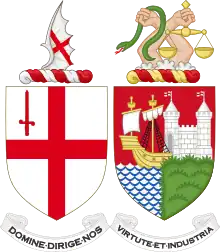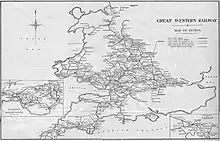 | |
 Map of the railway pre-grouping (1920) | |
| History | |
|---|---|
| 1835 | Act of incorporation |
| 1838 | First train ran |
| 1869–92 | 7 ft 1⁄4 in (2,140 mm) Brunel gauge changed to 4 ft 8+1⁄2 in (1,435 mm) standard gauge |
| 1903 | Start of road motor services |
| 1923 | Keeps identity though the Grouping |
| 1935 | Centenary |
| 1948 | Nationalised |
| Successor organisation | |
| 1948 | British Rail, Western Region |
| Constituent companies | |
| See full list of constituents of the GWR | |
| 1854 | Shrewsbury and Birmingham Railway Shrewsbury and Chester Railway |
| 1862 | South Wales Railway |
| 1863 | West Midland Railway |
| 1876 | Bristol and Exeter Railway South Devon Railway |
| 1889 | Cornwall Railway |
| 1922 | Rhymney Railway Taff Vale Railway Cambrian Railways |
| 1923 | Midland & S W Junction Railway |
| Key locations | |
| Headquarters | Paddington station, London |
| Locale | England; Wales |
| Workshops | Swindon Wolverhampton |
| Major stations | Birmingham Snow Hill Bristol Temple Meads Cardiff General London Paddington Reading General |
| Route mileage | |
| Mileage shown as at end of year stated[1][2][3][4][5] | |
| 1841 | 171 miles (275 km) |
| 1863 | 1,106 miles (1,780 km) |
| 1876 | 2,023 miles (3,256 km) |
| 1899 | 2,504 miles (4,030 km) |
| 1919 | 2,996 miles 68 chains (4,823.0 km) |
| 1921 | 3,005 miles (4,836 km) |
| 1924 | 3,797 miles (6,111 km) |
| 1925 | 3,819 miles 69 chains (6,147.5 km) |
The Great Western Railway (GWR) was incorporated by an act of Parliament in 1835 and nationalised on 1 January 1948. During this time it amalgamated with, or purchased outright, many other railway companies. These are listed here in two groups. The early amalgamations (mostly between 1843 and 1900) often involved railway companies that were already being financially supported by the GWR. The Railways Act 1921 brought many new companies into the fold including many successful Welsh lines.
List key
- (date) – the date on which the company was amalgamated into, or purchased by, the GWR.
- ♠ – Companies that were already operated by or leased to the GWR or one of the other absorbed railways before amalgamation. Note: This list is incomplete.
- ‡ – Companies operating wholly or partly on the 7 ft 1⁄4 in (2,140 mm) broad gauge at the time that they combined with the GWR. The broad gauge was finally abandoned on 21 May 1892.
Early amalgamations and purchases
- Cheltenham and Great Western Union Railway (1 July 1843) ♠ ‡
- Oxford and Rugby Railway (14 May 1846) ♠ ‡
- Berks and Hants Railway (14 July 1846) ♠ ‡
- Monmouth and Hereford Railway (1846)
- Wilts, Somerset and Weymouth Railway (14 March 1850) ♠ ‡
- Shrewsbury and Birmingham Railway (1 September 1854)
- Shrewsbury and Chester Railway (1 September 1854)
- Birkenhead Railway (1 January 1860)
- South Wales Railway (1 January 1862) ♠ ‡
- West Midland Railway (1 August 1863)
- Vale of Neath Railway (1 February 1865) ‡
- Aberdare Valley Railway
- Wycombe Railway (31 January 1867) ♠
- Bristol and South Wales Union Railway (1 August 1868) ♠ ‡
- Tenbury and Bewdley Railway (12 July 1869)
- Stourbridge Railway (1 February 1870)
- Great Western and Brentford Railway (1 July 1871) ♠
- Wallingford and Watlington Railway (2 December 1871)
- Wrexham and Minera Railway (1871)
- Llanelly Railway (1 January 1873)
- Llynvi and Ogmore Railway (1 July 1873)
- Gloucester and Dean Forest Railway (30 June 1874) ♠
- East Somerset Railway (2 December 1874) ♠
- Bristol and Exeter Railway (1 January 1876) ‡
- South Devon Railway (1 February 1876) ‡
- West Cornwall Railway (1 February 1876) ‡
- Wellington and Drayton Railway (30 August 1877) ♠
- Monmouthshire Railway (1 August 1880) ♠
- Culm Valley Light Railway (5 August 1880) ♠
- Malmesbury Railway (6 August 1880) ♠
- Carmarthen and Cardigan Railway (1 July 1882)
- Berks and Hants Extension Railway (10 August 1882) ♠
- Torbay and Brixham Railway (1 January 1883) ♥
- Festiniog and Blaenau Railway (10 September 1883)
- Stratford-upon-Avon Railway (1 July 1883) ♠
- Watlington and Princes Risborough Railway (1 January 1884)
- Whitland and Cardigan Railway (1 September 1886)
- Faringdon Railway (1 July 1886)
- Worcester, Bromyard and Leominster Railway (1 July 1888)
- Cornwall Railway (1 July 1889) ‡
- Calne Railway (1 July 1892) ♠
- Newent Railway (1 July 1892)
- Ross and Ledbury Railway (1 July 1892)
- Wellington and Severn Junction Railway (1 July 1892)
- Cornwall Minerals Railway (1 July 1896) ♠
- Pembroke and Tenby Railway (1 July 1896)
- Corwen and Bala Railway (7 August 1896)
- Llangollen and Corwen Railway (7 August 1896)
- Marlborough Railway (7 August 1896)
- Milford Railway (7 August 1896)
- Vale of Llangollen Railway (7 August 1896)
- Wenlock Railway (7 August 1896)
- Banbury and Cheltenham Direct Railway (1 July 1897)
- Buckfastleigh, Totnes and South Devon Railway (1 July 1897)
- Kington and Eardisley Railway (1 July 1897)
- Nantwich and Market Drayton Railway (1 July 1897) ♠
- Minehead Railway (6 August 1897) ♠
- North Pembrokeshire and Fishguard Railway (1 July 1898)
- Helston Railway (2 August 1898) ♠
- Leominster and Kington Railway (2 August 1898)
- Staines and West Drayton Railway (1 July 1900) ♠
- Golden Valley Railway (Pontrilas to Hay Junction) (1 May 1901) ♠
- Bridport Railway (26 July 1901) ♠
- Devon and Somerset Railway (26 July 1901) ♠
- Ely Valley Railway (South Wales) (11 August 1903)
- Wye Valley Railway (4 August 1905)
- Lambourn Valley Railway (1 July 1906)
- Manchester and Milford Railway (1 July 1907)
- Bala and Festiniog Railway (26 July 1910)
Railways Act 1921
The Railways Act 1921 provided for the compulsory amalgamation of many of Britain's railways. 27 of the larger railways (termed "Constituent Companies" by the act) would amalgamate on or before 1 January 1923 to create four larger railways (termed "Amalgamated Companies"). About 100 of the smaller railways (termed "Subsidiary Companies") would be absorbed by either the Constituent Companies or the Amalgamated Companies. In what was termed the "Western Group", the Constituent Companies were:
- Alexandra (Newport and South Wales) Docks and Railway 10+1⁄2 miles (17 km)
- Barry Railway 68 miles (109 km)
- Cambrian Railways 295+1⁄4 miles (472 km)
- Cardiff Railway 11+3⁄4 miles (19 km)
- Great Western Railway
- Rhymney Railway 51 miles (82 km)
- Taff Vale Railway 124+1⁄2 miles (199 km)
These amalgamated on 1 January 1922, and the company continued to use the name Great Western Railway, and its new board of directors included representatives from all seven of the constituent companies. There was no board representation for the Subsidiary Companies, which were:
- Brecon and Merthyr Railway (1 July 1922) 59+3⁄4 miles (97 km)
- Burry Port and Gwendraeth Valley Railway (1 July 1922) 21 miles (34 km)
- Cleobury, Mortimer and Ditton Priors Railway (1 January 1922) 12 miles (19 km)
- Didcot, Newbury and Southampton Railway (1923) 42+3⁄4 miles (68 km) ♠
- Exeter Railway 8+3⁄4 miles (14 km) ♠
- Forest of Dean Central Railway 5 miles (8 km) ♠
- Gwendraeth Valley Railways (1 January 1923) 3 miles (5 km) ♠
- Lampeter, Aberayron and New Quay Light Railway 12 miles (19 km) ♠
- Liskeard and Looe Railway 9 miles (14 km) ♠
- Llanelly and Mynydd Mawr Railway (1 January 1923) 13 miles (21 km)
- Mawddwy Light Railway ♠
- Midland and South Western Junction Railway (1 July 1923) 63+1⁄4 miles (101 km)
- Neath and Brecon Railway (1 July 1922)
- Penarth Extension Railway 1+3⁄4 miles (3 km) ♠
- Penarth Harbour, Dock and Railway 9+3⁄4 miles (16 km) ♠
- Port Talbot Railway (1 January 1922) 35 miles (56 km)
- Princetown Railway (1922) 10+1⁄2 miles (17 km)
- Rhondda and Swansea Bay Railway (1 January 1922) 29 miles (46 km) ♠
- Ross and Monmouth Railway 12+1⁄2 miles (20 km) ♠
- South Wales Mineral Railway 13 miles (21 km) ♠
- Teign Valley Railway 7+3⁄4 miles (12 km) ♠
- Vale of Glamorgan Railway 20+3⁄4 miles (33 km) ♠
- Van Railway ♠
- Welshpool and Llanfair Light Railway ♠
- West Somerset Railway (1922) 14+1⁄2 miles (23 km) ♠
- Wrexham and Ellesmere Railway ♠
After the grouping, two organisations voluntarily sold their operations and locomotives to the GWR. Both of these worked the railways of Swansea Docks:
- Swansea Harbour Trust (1 July 1923)
- Powlesland and Mason (contractors at Swansea Docks) (1 January 1924)
Later, the GWR purchased the Corris Railway from the Bristol Tramways and Carriage Company Ltd, together with associated road services and vehicles.[6]
- Corris Railway (4 August 1930)
References
- ↑ MacDermot, E T (1927). "Appendix 1". History of the Great Western Railway, volume I 1833-1863. London: Great Western Railway. Reprinted 1982, Ian Allan, ISBN 0-7110-0411-0
- ↑ MacDermot, E T (1931). "Appendix 1". History of the Great Western Railway, volume II 1863-1921. London: Great Western Railway. Reprinted 1982, Ian Allan, ISBN 0-711004-12-9
- ↑ "A brief review of the Company's hundred years of business". Great Western Railway Magazine. Great Western Railway. 47 (9): 495–499. 1935.
- ↑ The Railway Year Book for 1920. London: The Railway Publishing Company Limited. 1920. p. 154.
- ↑ The Railway Year Book for 1926. London: The Railway Publishing Company Limited. 1926. pp. 154–172.
- ↑ Cozens, Lewis (1972) [1949]. The Corris Railway. Leicester: The Corris Railway Society. p. 27.
- The Locomotives of the Great Western Railway, Part 3: Absorbed Engines 1854-1921. The Railway Correspondence and Travel Society. 1956.